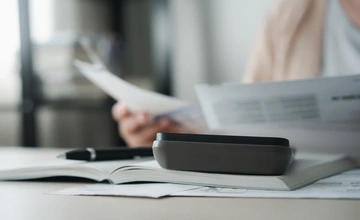Planning for retirement is something we'll all have to consider at some point. We’re going to look at ways you can supplement your pension income and prepare for your future.
You should always get independent financial advice and do thorough research before making any high-risk investments or buying property.
Individual Savings Accounts (ISAs)
ISAs let you save money tax-free. For the 2024/2025 tax year, you can save a maximum of £20,000 spread across all types of ISA. The types of ISAs are: cash, stocks and shares, innovative finance, and lifetime. They all have different terms and conditions, and risks, so it’s really important to know what you’re signing up to. For example, some ISAs let you withdraw your money whenever you want, while others make you invest for a fixed period.
Cash ISA
The simplest ISA is the cash ISA. You can start with as little as £1 and they’re usually free of setup costs. They have minimal risk because you’re not gambling your money like with stocks and shares.
Most banks are part of the Financial Services Compensation Scheme (FSCS) meaning your money is protected up to £85,000. However, National Savings and Investments (NS&I) is a government savings bank that offers a cash ISA which guarantees protection of 100% of your money.
Stocks & Shares ISA
This type of ISA invests your money in stocks and shares. They’re not meant for short-term saving and are best kept for at least five years. You can choose how hands-on you are - whether you choose the investments yourself or let the provider do so. There’s also a middle-ground option where you choose the investments but with some guidance. You could choose to receive regular payments from the ISA, to supplement your pension for example. Or you could invest for a fixed period and withdraw the money at the end. While the returns have the potential to be bigger than a cash ISA, the risk is greater. There are usually fees to set-up and maintain this type of ISA, and only the first £50,000 of your money is protected.
Innovative Finance ISAs
These ISAs are for investing in peer-to-peer lending. This means you invest your money which is then matched up to either an individual, property developer or companies who are looking to borrow. The benefit you get, is from the interest. These are the riskiest of all ISAs because they’re not covered by the £85,000 protection from the FSCS, and several have collapsed in recent years. If the borrower fails to pay back your money, you may lose your entire investment. You may also have to wait a certain amount of time before you can withdraw your money so if you’re likely to need access then it’s something to bear in mind.
Lifetime ISAs (LISAs)
If you’re between the ages 18 and 40 you can open a Lifetime ISA. They’re designed to be long-term saving plans. The maximum you can put in is £4,000 each year. The great thing about these is that the government will add 25% of the amount you’ve invested, so they can be a good way to boost your retirement fund. If you withdraw the money before you’re 60 years old, you’ll have to pay a 25% charge. The only way to avoid this charge is if you’re using the money to buy your first home. You can open a cash LISA or a stocks and shares LISA.
If you’re looking for ways to save money to put into an ISA, check out these money-saving ideas.
Invest in property
Another way of saving for retirement is to put your money into property. Some people see this as a low-risk option for long-term saving, however this depends on the area and the demand of the property. You might be able to take a rental income from the property or sell it and use the money for living expenses. You’ll have to consider the pros and cons of the property market carefully. The potential stress of being a landlord, and what your tax implications might be on owning, or selling a second home are something to consider. When you come to sell it, you'll need to bear in mind that you may be subject to Capital Gains Tax as well.
Property values can go down as well as up, but if you view this is a long-term investment it could provide a good return.
Save some income each month
The current full rate State Pension is around £11,500 a year, depending on your National Insurance contributions. If you think you’ll need more than this to live comfortably then you need to think of ways to add to it. You could start saving a percentage of your income every month, or a fixed amount, whichever works best for you. Invest it into your existing pension scheme, or open an ISA. You could save it in a standard savings account but if the interest rate is low you might need to save more each month. If you saved £86 a month for 22 years, you could add around £40,000 to your pension pot.
Disclaimer: We make every effort to ensure content is correct when published. Information on this website doesn't constitute financial advice, and we aren't responsible for the content of any external sites.
BACK TO BLOG HOME







